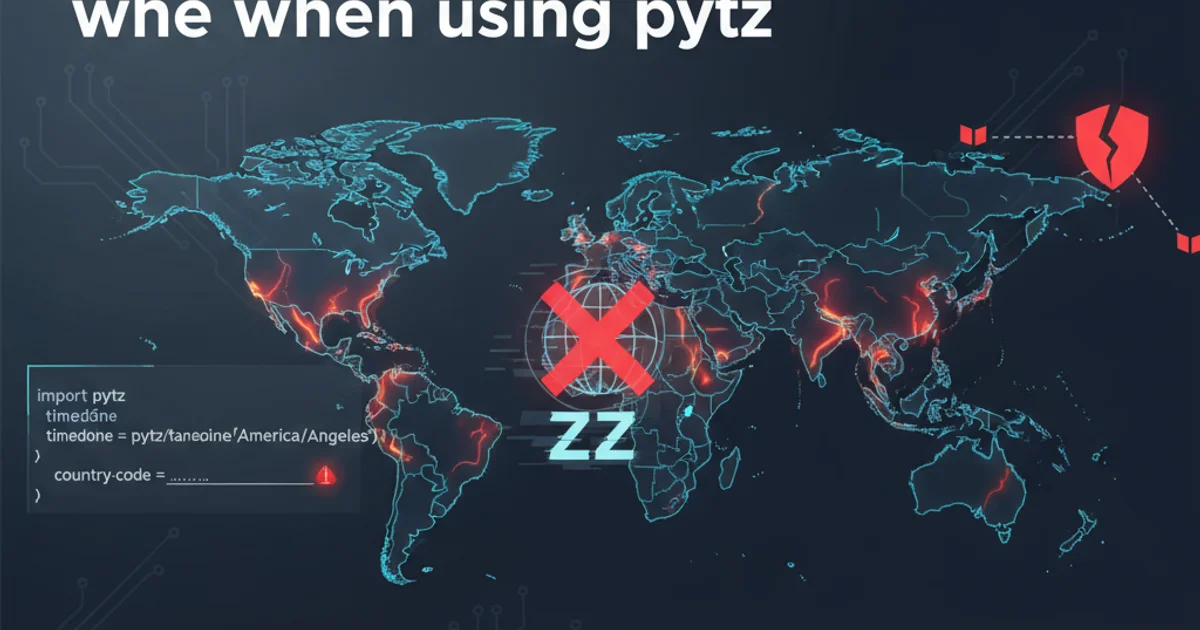I am getting 'ZZ' as country code when using pytz
Categories:
Resolving 'ZZ' Country Code with pytz in Google App Engine

Learn why pytz might return 'ZZ' for timezones in Google App Engine (Python 2.7) and how to correctly determine a user's country code.
When working with pytz in a Google App Engine (GAE) Python 2.7 environment, developers often encounter 'ZZ' as the country code for certain timezones. This can be confusing, as 'ZZ' is typically used as a reserved code for 'unknown or unspecified country'. This article delves into the reasons behind this behavior and provides robust solutions for accurately determining a user's country code, especially when relying on timezone information.
Understanding the 'ZZ' Phenomenon in pytz
The pytz library, while excellent for handling timezone conversions, primarily maps timezone names (like 'America/New_York') to UTC offsets and daylight saving rules. It does not inherently provide a direct, one-to-one mapping from every timezone to a single country code. The 'ZZ' code you observe often arises when pytz cannot confidently associate a given timezone with a specific country based on its internal data or when a timezone spans multiple countries. This is particularly true for timezones that are historical, generic, or cover vast geographical areas.
flowchart TD
A[User Request] --> B{Determine Timezone}
B --> C{Use `pytz` to get timezone info}
C --> D{Extract Country Code from `pytz`}
D{Country Code == 'ZZ'?} -- Yes --> E[Problem: Unknown Country]
D -- No --> F[Success: Valid Country Code]
E --> G[Need Alternative Method]Flowchart illustrating the 'ZZ' country code issue with pytz.
Why pytz Isn't Ideal for Country Code Lookup
While pytz is built upon the IANA Time Zone Database (also known as tzdata), the database's primary purpose is to track time zone rules, not political boundaries. Many timezones are not exclusive to a single country, or their boundaries have changed over time. For example, 'Europe/London' is primarily associated with the UK, but historically, its rules might have applied to other regions. When pytz attempts to infer a country from a timezone, it relies on metadata that might be ambiguous or simply not designed for precise country identification. Google App Engine's environment (Python 2.7) doesn't alter pytz's core behavior in this regard; it's a characteristic of the library itself.
Reliable Methods for Country Code Determination
To accurately determine a user's country code, especially in a web application context like Google App Engine, relying solely on pytz's timezone-to-country mapping is insufficient. Instead, you should leverage information available from the user's request or dedicated geolocation services. Here are the most common and reliable approaches:
1. Use Request Headers (GAE Specific)
Google App Engine often provides geographical information in request headers. The X-AppEngine-Country header is particularly useful, as it contains the two-letter ISO 3166-1 alpha-2 country code of the user's origin. This is the most straightforward and recommended method for GAE applications.
2. Client-Side Geolocation
For browser-based applications, you can use the browser's Geolocation API (navigator.geolocation) to get the user's precise location (latitude and longitude) with their permission. This data can then be sent to your server and reverse-geocoded using a service like Google Maps Geocoding API to obtain the country code.
3. IP Geolocation Services
If client-side geolocation isn't an option or is blocked, you can use the user's IP address (available via self.request.remote_addr in GAE) with a dedicated IP geolocation API (e.g., MaxMind GeoIP, IPinfo.io). These services map IP addresses to geographical locations, including country codes. Be mindful of API quotas and performance implications.
import os
def get_country_code_gae_header():
"""Retrieves the country code from Google App Engine request headers."""
country = os.environ.get('HTTP_X_APPENGINE_COUNTRY')
if country and country != 'ZZ': # 'ZZ' can also be returned if country is unknown
return country
return None
# Example usage in a GAE request handler
# class MyHandler(webapp2.RequestHandler):
# def get(self):
# country_code = get_country_code_gae_header()
# if country_code:
# self.response.write('User country: {}'.format(country_code))
# else:
# self.response.write('Could not determine user country.')
Example of retrieving country code from GAE request headers.
X-AppEngine-Country is generally reliable, it can sometimes return 'ZZ' if Google cannot determine the country. Always have a fallback mechanism.Integrating Geolocation with Timezone Handling
Once you have a reliable country code, you can use it in conjunction with pytz if you need to infer a timezone based on the country. However, it's often better to let the user select their timezone or infer it from client-side JavaScript, as a country can have multiple timezones. If you must infer, you can use libraries that map country codes to common timezones within that country, but this will still be an approximation.
import pytz
def get_timezones_for_country(country_code):
"""Attempts to get timezones for a given country code (approximate)."""
# pytz does not directly map country codes to timezones in a simple way.
# This is a conceptual example; a dedicated library or database is better.
# For demonstration, we'll use a hardcoded mapping or a more complex lookup.
# A more robust solution would involve a library like 'timezonefinder'
# or a custom database mapping ISO country codes to common IANA timezones.
# Example: Manual mapping for a few countries (not comprehensive)
country_timezone_map = {
'US': ['America/New_York', 'America/Los_Angeles'],
'GB': ['Europe/London'],
'AU': ['Australia/Sydney', 'Australia/Perth']
}
return country_timezone_map.get(country_code.upper(), [])
# Example usage:
# country = get_country_code_gae_header()
# if country:
# possible_timezones = get_timezones_for_country(country)
# print('Possible timezones for {}: {}'.format(country, possible_timezones))
Conceptual example of mapping country codes to timezones (requires external data or library).